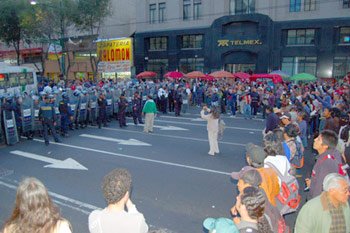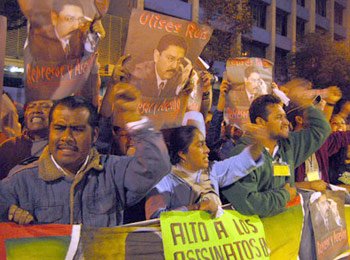


Members of the APPO and the Other Campaign Marched and Held a Blockade in the City Center
They Denounce the Deaths of Two Compañeros, a Minor and Fifty Detentions; Violent Incidents Occurred with the Police, Provoked by Masked Infiltrators
By Juan Trujillo and Erwin Slim
The Other Journalism with the Other Campaign in Mexico City
November 5, 2006
México City, México, October 29: After hearing of the federal and state police raid on the capital of Oaxaca at 3:50pm, diverse social organizations, collectives and members of the Popular Assembly of the People of Oaxaca (APPO), as did the members of the Zapatista “Other Campaign,” marched and held a blockade in the center of this city at the Palace of Fine Arts, on the central avenue of Lázaro Cárdenas and Francisco I. Madero.
 Photos: D.R. 2006 Erwin Slim |
3:10pm: From Oaxaca, University Radio and commercial radios transmit the beginning of the violence in the downtown, reporting on beatings and the use of tear gas by the Federal Preventative Police (PFP). The reports emphasize that masked men were entering the Miguel Alemán Colony in the state capital to intimidate and search private homes.
4pm: In journalist Carmen Aristegui’s radio coverage, the governor of Oaxaca, Ulises Ruíz Ortiz, affirmed that the solution in Oaxaca does not imply his resignation, while at the same time labeling the member organizations of the APPO as “radical groups.”
The Rally and the Violence of the Masked Infiltrators
In the Hemiciclo to Juárez, very close to the zócalo and the political heart of the country, the members and sympathizers with the APPO (which has a commission of twenty-one members who have been on a prolonged hunger strike and are assembled permanently in this point) and a group of no more than sixty adherents of The Other Campaign held councils and assemblies. As the minutes passed more sympathizers, anarchist collectives, communists and some delegates from the PRD-loyal Democratic National Convention began to join together in Madero Street.
 |
The spontaneity of this collective action was evident. There was no political leadership capable of organizing the protesters nor was there really a possibility to establish a dialogue with the police chiefs. This created a ready environment for a group of visibly homogenous youth with masked faces initiating violence against the those in uniforms. These infiltrators, who claimed to be students, physically and verbally assaulted the members of the Secretary of Public Security. Minutes later, once traffic became non-existent, the masked men took over two public trolleys, which were found laying vertically on the street with flat tires symbolizing a barricade.
Various commentaries and testimonies of men and women reproached the form of participation of the violent group, to the point of de-legitimizing them, pointing out the example of the APPO in Oaxaca, which as a general principle have choosen peaceful action. In either case, many of them decidedly supported the blockade to protest the police invasion in the southern state.
 |
6pm: From the Lázaro Cárdenas Ave, various groups of the capitol police arrived, while the protesters shouted, “not one step back, Oaxaca is everyone.” The police departments were identified as: “GEM Police,” “West Granaderos Metropolitan Police,” and “AFT Police.” The uniformed, in these moments, stood immobile and without confrontation. During an interval of slightly less tension, APPO members called to march toward Hidalgo street to take Reforma Avenue and hold a rally in front of “Caballito” and called it the “informative corner.”
Despite the lack of tension between the protesters and the police, the infiltrators, whom the other organizations could not control, continued to exercise violence, so much so that they began to have conflicts and be verbally aggressive with humble and simple people that did not accept them. Diverse individuals, in contrast, expressed pacifism as their form of participation in support of the Oaxacan movement.
APPO: “If Ulises Does Not Go, Calderón Will Not Pass”
Minutes prior to 7pm, the march had arrived at the “Informative Corner” where the stations of the media groups El Universal and Exelsior were. In front of a little more than three thousand people, a meeting was held in which Cesar Mateos (among other spokespeople of the APPO), pronounced that if “Ulises does not go soon, Felipe Calderón, the illegitimate president, will not pass.” The people exclaimed “Ulises has fallen and Calderón follows.” Mateos reiterated the peaceful character of the Oaxacan movement and asked not to fall prey to provocations, despite the repression and the assassination of their compañeros.
Antonio Garfias, another spokesperson of the APPO, decried the death (which he later confirmed to Narco News) of Jorge Albert López Bernal, caused by an impacted explosive to the chest, during a confrontation in Oaxaca with the PFP.
In the same sentiment, he affirmed that the “community is resisting approximately six thousand active police, in various places such as Santa Rose,” while maintaining that there are people who “are coming down from the hills” to fight the repression.
One spokesperson of the movement placed the blame on different police corporations such as the AFI and others sent from Puebla and Chiapas that had penetrated into Oaxaca. Later he denounced the fact that at least fifty compañeros were detained by helicopters.
7pm: The march arrived at the Secretary of the Government, passing on its route the stations of the television company Televisa. Here there were fifteen Federal Preventative Police and large police barricades of mesh. The masked groups of infiltrators knocked down sixty percent of the barricades without the police taking any action.
 |
Moments later, a spokesperson proposed a meeting of the National Assembly of the People of México on the 18th and 19th of November and reported that “in these very moments, Section VII of the National Union of Educational Workers, in Chiapas, is taking the highways.”
In the end, in the name of the APPO, one of the representative asked that the students of UNAM “blockade Avenue Insurgentes the following day at 7am.” Tomorrow, Monday, also, a march will be held, departing from the Hemiciclo a Juárez at 2pm, ending at the Ministry of the Interior.
Detainees After the March
In recent reports, the Center for Free Press confirmed that at the end of the march, a group of protesters were detained by the police. At 10:15pm, they reported: “After the protest on Avenue Reforma, the police detained eleven compañeros on their way to Hemiciclo a Juárez. They were detained by uniformed civil police with billy-clubs. They approached them with the use of violence and called on two patrols that transported them to agency fifty, where they accused them of robbery and the destruction of a patrol. The names of the detained are Iliana Coapio, Adhazaira Chávez, Jazmin Ornelas Gómez, Pablo Dorantes, Heriberto Paredes, Victor Duarte Alanis, Gerardo Florencio, Teresa Salgado Cordero, Cintya Castro, Elizabeth Vayadores, Demián Gómez Medina. Once inside the MP (Public Ministry), they noticed four other detainees, two women and two men, of whom we only have the names of the men: Juan Luis (from the Zapatista Front), Arturo Martínez (Pirate Collective),” concluded the report.
Translated from Spanish Novemeber 5
Click here for more Narco News coverage of Mexico
Lea Ud. el Artículo en Español
- The Fund for Authentic Journalism
For more Narco News, click here.




